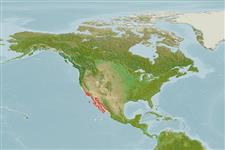Environment: milieu / climate zone / profondeur / distribution range
Écologie
marin; saumâtre démersal; profondeur 1 - 91 m (Ref. 48844), usually 1 - 13 m (Ref. 48844). Tropical; 38°N - 18°N, 123°W - 106°W (Ref. 114953)
Eastern Pacific: endemic to the eastern Pacific from San Francisco, USA to the Gulf of California, and possibly to Mazatlan, Mexico (Ref. 48844).
Length at first maturity / Taille / Poids / Âge
Maturité: Lm ?, range 57 - ? cm
Max length : 119 cm TL mâle / non sexé; (Ref. 48844); 170.0 cm TL (female); poids max. publié: 9.8 kg (Ref. 40637); poids max. publié: 9.8 kg; âge max. reporté: 16 années (Ref. 48844)
Description synthétique
Clés d'identification | Morphologie | Morphométrie
Broad disc is greater in length than width; a relatively smooth dorsal surface except for a single row of thorns around the eyes and extending along the back and tail; a long, pointed snout with a rounded tip; small, rounded, pebble-like teeth; a first dorsal fin that originates closer to the pelvic fin base than to the caudal fin origin; a thick tail and a moderately large caudal fin without a distinct lower lobe. Tooth count: 102-112/98-117. Spiral valve count: 8-10.
Body shape (shape guide): elongated.
Found on sand or mud bottoms of bays, seagrass beds, estuaries, and near rocky reefs. Nomadic and gregarious. Found singly or in aggregations (Ref. 12951). Burrows in sand during the day, feeds on crabs, worms, clams and small fishes at night (Ref. 12951). Ovoviviparous, with 6 to 28 pups in a litter (Ref. 48844). Females mature by 7 years at 87-99 cm TL; males reaches 91-110 cm TL; birth size at 20-24 cm TL (Ref. 114953).
Etymology: The genus comes from the Greek word rhine, meaning shark, and the Latin word batis, meaning ray, in reference to its body form being intermediate between that of a shark and a ray. The species name comes Latin, meaning produced, in reference to its pointed snout (Ref. 48844).
Exhibit ovoviparity (aplacental viviparity), with embryos feeding initially on yolk, then receiving additional nourishment from the mother by indirect absorption of uterine fluid enriched with mucus, fat or protein through specialised structures (Ref. 50449).
Adults of both sexes congregate during the breeding season in shallow bays and estuaries and likewise leave when the pupping season is over after mating (Ref. 48844). Gestation lasts for about 12 months (Ref. 48844).
Eschmeyer, W.N., E.S. Herald and H. Hammann, 1983. A field guide to Pacific coast fishes of North America. Boston (MA, USA): Houghton Mifflin Company. xii+336 p. (Ref. 2850)
Statut dans la liste rouge de l'IUCN (Ref. 130435: Version 2025-1)
Utilisations par l'homme
Pêcheries: commercial; pêche sportive: oui
Outils
Articles particuliers
Télécharger en XML
Sources Internet
Estimates based on models
Preferred temperature (Réf.
123201): 15.3 - 25.9, mean 22.4 °C (based on 149 cells).
Phylogenetic diversity index (Réf.
82804): PD
50 = 0.5020 [Uniqueness, from 0.5 = low to 2.0 = high].
Bayesian length-weight: a=0.00209 (0.00137 - 0.00319), b=3.10 (2.97 - 3.23), in cm total length, based on LWR estimates for this species & Genus-body shape (Ref.
93245).
Niveau trophique (Réf.
69278): 3.6 ±0.3 se; based on diet studies.
Generation time: 11.0 ( na - na) years. Estimated as median ln(3)/K based on 2
growth studies.
Résilience (Réf.
120179): Faible, temps minimum de doublement de population : 4,5 à 14 années (tm=7; tmax=11; K=0.1; Fec = 6).
Fishing Vulnerability (Ref.
59153): High vulnerability (65 of 100).
🛈
Nutrients (Ref.
124155): Calcium = 32.6 [8.1, 140.3] mg/100g; Iron = 0.666 [0.163, 1.807] mg/100g; Protein = 18.8 [16.7, 20.7] %; Omega3 = 0.146 [0.065, 0.333] g/100g; Selenium = 50.9 [14.7, 138.9] μg/100g; VitaminA = 12.1 [5.5, 26.8] μg/100g; Zinc = 1.03 [0.51, 1.86] mg/100g (wet weight);
